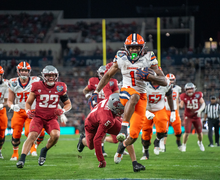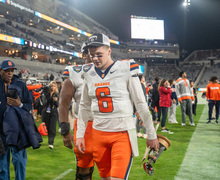MBB : Rule of 3: 25 seasons after NCAA implementation, 3-pointer has won games, gained approval
In one moment, Bobby Cremins went from pulling his hair out to jumping for joy.
With a clear path to the basket in the second round of the 1990 NCAA Tournament, his star player, Dennis Scott, nearly squandered his team’s chance to tie the game. Scott waited and dribbled away from his teammates on a fast break in the second half, leaving Cremins, the Georgia Tech coach, confused on the sidelines.
Cremins didn’t have a chance to wonder what in the world Scott was thinking. Scott, the 1989-90 National Player of the Year, pulled up on the wing for a 3-pointer that swished through the net, giving the Yellow Jackets a one-point lead over Louisiana State.
‘I was going crazy until he hit it,’ said Cremins, who coached Scott and the Yellow Jackets to their first Final Four appearance in 1990, defeating LSU 94-91 along the way. ‘You get used to those kind of moments with the 3-point line and a great shooter.’
The 3-pointer, a shot that seems so ingrained in contemporary college basketball, turns 25 years old this season. Before the 1986-87 season, 3-point plays only existed the hard way: making a field goal, getting fouled and making the free throw. Scott and the 3-point shooters that followed changed all that, helping shift the perception of the shot from oddity to exciting and building basketball careers from behind the arc.
The NCAA adopted the 3-point line in 1986, based on years of research and polling by Ed Steitz, then the secretary-editor of the NCAA basketball rules committee.
That research started on a slab of pavement in Steitz’s backyard, where the neighborhood kids gathered, laced up their Chuck Taylors and guarded his son, Bob Steitz.
Bob Steitz was no basketball prodigy. He was a kid growing up in the 1970s with a decent jumper and had his own backyard court. The neighborhood kids were simply grateful to have a place to play, so they didn’t mind that at any given moment Ed Steitz would interrupt their game and make his son take long-range shots from any spot on the court.
Sometimes Steitz would ask the defense to play tight. Other times, they would play off Bob Steitz. Either way, Steitz furiously scribbled down the outcome.
In some way, the future of college basketball was hovering over that backyard court. Steitz inched closer to his newest conclusion each time he noted his son’s shooting percentage during those backyard shootarounds.
College basketball, the game he loved and was charged with protecting, needed a 3-point shot.
‘All of us neighborhood kids thought he was crazy,’ said Bob Steitz, now the Villanova senior associate athletic director for external operations. ‘But even though no one was calling for the 3-point line in college basketball, he had the foresight to stand up and say the sport needed it.’
Without a 3-point line, bigger, taller and more physical teams dominated. Before shooters had an incentive to knock down a 3, all guards needed to do was get the ball down low.
But big-name coaches like Mike Krzyzewski and Bob Knight dismantled the rule change publicly. Former St. John’s head coach Lou Carnesecca dubbed the 3-pointer ‘a Mickey Mouse shot.’
Still, Steitz stuck to his guns. The game needed to change, and he was the man to change it. ‘It’s going to force teams to play more defense away from the basket,’ Steitz said when the 3-pointer was first adopted. ‘People will say, ‘You’re putting the little man back in the game,’ and that’s good.’
Coaches like Krzyzewski, Knight and Carnesecca had no idea just how good the game would become with the little man back in the fold.
Bob Steitz attributes the ‘madness’ of the NCAA Tournament to his father’s rule, which evened the playing field for mid-major programs. Steitz said his father, who died in 1990, would absolutely love to see the tournament runs that Cinderella teams such as Davidson, George Mason and Valparaiso have made over the years using the 3-pointer.
Valparaiso’s 1998 NCAA Tournament first-round upset of Mississippi — capped off by a dramatic 3-pointer — is still talked about every March nearly 14 years later.
Homer Drew can’t escape the legendary 3-pointer his son, Bryce, hit to top the Rebels 70-69 on March 13, 1998, in Oklahoma City. Not that he wants to. The former Valparaiso head coach can’t get enough of the moment college basketball fans have simply called ‘The Shot.’
But before ‘The Shot,’ there was ‘Pacer,’ the name given to the play Drew called with their tournament hopes on the line. With 2.5 seconds left, 13th-seeded Valparaiso was down two points against fourth-seeded Mississippi when guard Jamie Sykes stood behind the line to inbound the ball from the far end of the court.
Sykes hurled the ball to midcourt, where forward Bill Jenkins tipped it to Bryce Drew for a 23-foot 3-pointer at the buzzer.
‘We would run that play about once a week in practice, and that was the best they’ve ever run it,’ Homer Drew said. ‘And I still can’t believe it goes in every time I watch it.’
Neither can Bryce Drew, now the current head coach at Valparaiso. CBS Sports still features the magical shot and the heap of players that piled on him before each March Madness pregame show.
‘I grew up loving to watch the NCAA Tournament,’ he said. ‘Making a play in one of its biggest moments? What a blessing.’
And without the 3-pointer, Homer Drew knows the moment he shared with his son would’ve never happened.
‘Having that line there has changed our lives profoundly,’ he said. ‘Players like Bryce have the same opportunity for great, memorable plays as other players do with the dunk, and the moments that accompany those plays have made the game 10 times better.’
Tom Crean would have a tough time arguing any differently. The Indiana head coach has watched his team defeat the Nos. 1 and 2 teams this season, using their strength from behind the arc to revive a traditional basketball powerhouse. The Hoosiers are second in the nation from 3, shooting at a 45-percent clip.
The highlight of those upsets was Christian Watford’s buzzer-beater from 3 to defeat then-No. 1 Kentucky on Dec. 10.
‘He stayed in his shot, he didn’t fade and he didn’t leg kick,’ said Crean, whose Indiana team is now ranked in the top 15. ‘It was picture-perfect form in a big-time moment.’
Scott made a name for himself hitting those picture-perfect 3s in big moments at Georgia Tech.
If Georgia Tech had a game at 7 p.m., Scott made sure he hit the court at 4 p.m. The Yellow Jackets counted on Scott to sink triples, and more often than not, he didn’t disappoint. But being one of college basketball’s first true 3-point specialists had a price, and Scott paid that by shooting 200 treys three hours before any game even started.
‘It was muscle memory to me,’ Scott said. ‘And once the game started, I already had a feel for what it took to hit the outside shot.’
Scott had the benefit of the 3-point line during his playing days at Flint Hill Prep in Oakton, Va., where high school coach Stu Vetter gave him the freedom to shoot from long range as many times as he wanted.
When Scott arrived to Georgia Tech in 1987, Cremins had no problem taking advantage of the defense by playing to his star’s strengths.
Once he got hot, Cremins said, Scott was unstoppable.
‘It was all about the 3,’ said Scott of that tournament run in 1990. ‘And it’s no secret that the 3-point shot changed the lives of so many players and coaches, including my own.’
Published on January 18, 2012 at 12:00 pm
Contact Nick: nctoney@syr.edu | @nicktoneytweets





